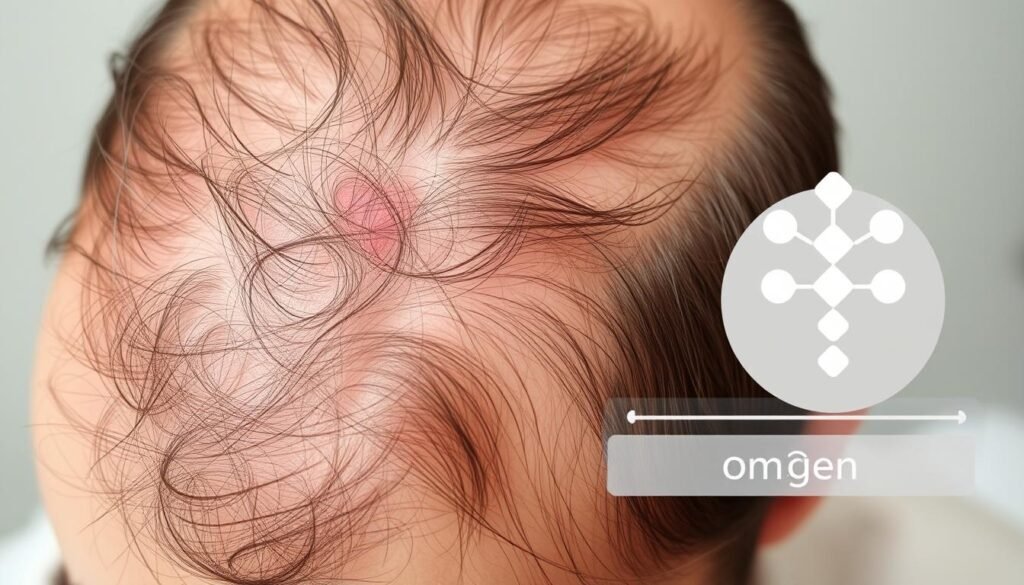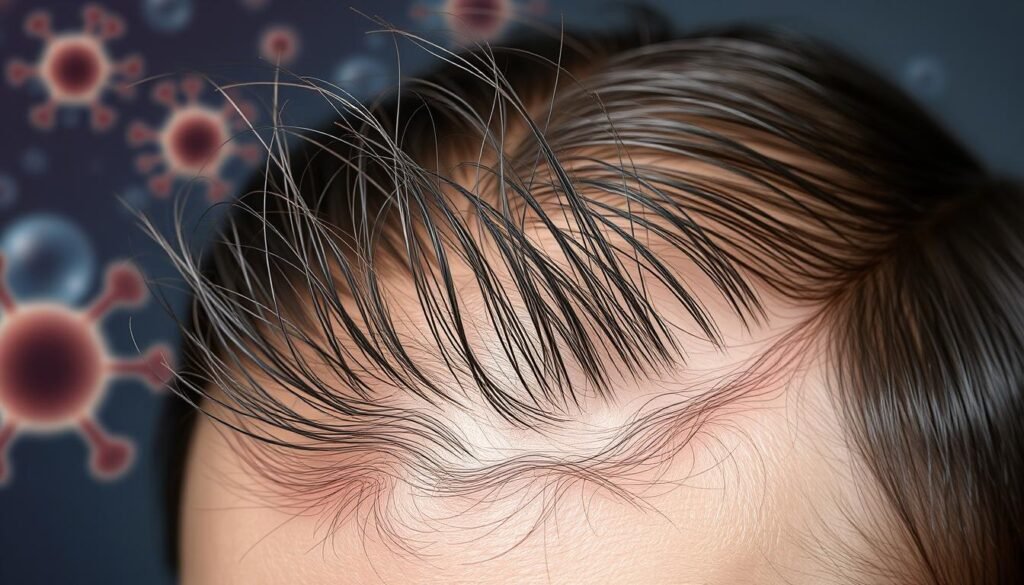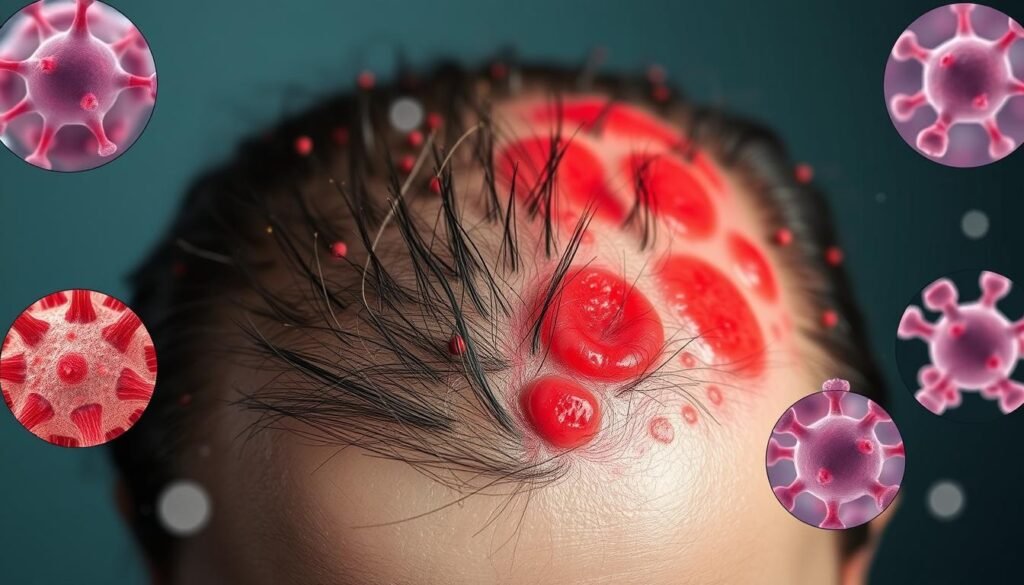Did you know up to 50% of men and women face androgenetic alopecia? This fact shows how important it is to understand high androgen levels. These hormones, especially dihydrotestosterone (DHT), are behind many hair thinning issues. Today, let’s dig into how hormones affect hair loss and scalp health.
Learning about the biological aspects of high androgens reveals why hair gets thinner. It also shows how losing hair can really affect someone emotionally. It’s crucial to look deeper into how these hormones impact people, especially those dealing with androgenetic alopecia.
Key Takeaways
- Androgenetic alopecia affects both genders, with up to 50% prevalence.
- Elevated dihydrotestosterone (DHT) is linked to hair thinning conditions.
- Understanding hormone imbalances is crucial for addressing scalp health issues.
- Psychosocial effects of hair loss can significantly impact individuals’ well-being.
- Effective treatments, like minoxidil and finasteride, can offer relief after consistent use.
Understanding Androgenetic Alopecia
Androgenetic alopecia is a common form of hair loss. It affects many people worldwide. Around 80% of Caucasian men and 50% of Caucasian women are hit by this condition, usually starting after puberty. It is known as male pattern baldness in men and female pattern hair loss in women. This highlights different hair loss patterns across genders.
Men with androgenetic alopecia often see their hair thinning in the forehead area and the top of their scalp. Women, on the other hand, usually experience a general thinning all over the scalp. Their hairline doesn’t recede like it does in men. These differences show how genes and hormones play specific roles in hair loss. Studies show that men and women have different levels of hair-related chemicals in their scalps, which influences why they lose hair differently.
The genetic basis of androgenetic alopecia is strong. Twin studies show a heritability rate of 81%. This underlines the significant role genes play in its onset and development. Over time, thick hair turns into fine hair, which decreases hair density. This leads to noticeable changes in how hair looks and how healthy the scalp feels.
Androgenetic alopecia is not just about losing hair. It might also link to health issues like high blood pressure and diabetes. Dealing with this hair loss is crucial for one’s overall health. It affects how people feel about themselves. Knowing more about these connections offers a complete picture of hair loss and its effects on life.
To manage androgenetic alopecia, it’s essential to look at treatments such as minoxidil and finasteride. These options can help manage the condition. Being proactive is key to handling its impact on life. To learn more about addressing hormonal imbalances, making lifestyle changes, and treatment plans, visit this resource.
What are Elevated Androgens?
Elevated androgens are important for our health, influencing functions like hair follicle health. Testosterone is a well-known androgen. However, there are also others like dihydrotestosterone (DHT), Androstenedione, Dehydroepiandrosterone (DHEA), and DHEA sulfate (DHEA-S). These hormones are vital for both males and females, aiding in muscle growth, red blood cell production, and sexual health.
For individuals assigned male at birth (AMAB), androgens lead to a deeper voice and more body hair. For those assigned female at birth (AFAB), androgens are converted into estradiol. This process affects menstruation and pregnancy. High androgen levels can come from conditions like polycystic ovary syndrome (PCOS) or adrenal tumors. These can cause a hormonal imbalance, affecting many bodily systems, including hair health.
It’s key to understand elevated androgens, especially regarding androgenetic alopecia, which impacts millions in the United States. The condition often stems from high DHT levels that lead to hair follicle miniaturization. Knowing how androgens affect hair growth cycles is crucial for tackling hair loss issues.
| Androgen | Function | Common Issues with Elevation |
|---|---|---|
| Testosterone | Mood, muscle mass, and sexual function | Increased body hair, hormonal imbalance |
| Dihydrotestosterone (DHT) | Regulates hair growth cycle | Hair thinning, androgenetic alopecia |
| Androstenedione | Converted to testosterone and estrogen | Hormonal irregularities |
| Dehydroepiandrosterone (DHEA) | Precursor to sex hormones | Potential increase in body fat |
Knowing about elevated androgens and their importance in hormonal balance is crucial. This understanding helps manage conditions affecting our well-being and hair follicle health.
Symptoms of Elevated Androgens and Hair Loss
The symptoms of high androgens can affect someone’s hair a lot. They often lead to hair loss, thinning hair, and skin problems. Along with these, people might face more oil on their skin, acne, and even mood swings. It’s key to spot these signs early.
Hair loss tends to start slowly. It’s usually seen at the top of the head or at the hairline. For women, the hair loss is spread out, making the hair less thick. In men, it often starts with the hairline moving back. Finding these signs early can help start treatments sooner. This may help reduce the hair loss.

| Symptom | Description | Gender Differences |
|---|---|---|
| Hair Loss | Gradual loss of hair, more noticeable in specific zones of the scalp | Men show a receding hairline; women exhibit diffuse thinning |
| Hair Thinning | Thinning hair strands leading to less voluminous hair | Women rarely experience complete baldness; thinning is common |
| Acne | Increased oiliness and breakouts on the skin | More prevalent in both men and women with elevated androgens |
| Mood Changes | Alterations in mood or energy levels, including irritability | Affects both genders |
Knowing about these symptoms helps people get the right help. Watching for changes can guide towards treatments. These treatments don’t just target hair loss. They also tackle the hormone issues behind these problems.
The Role of Elevated Androgens in Hair Loss and Scalp Issues
Elevated androgens play a big part in understanding hair loss, especially with androgenetic alopecia. Androgens like DHT affect hair follicles, leading to scalp problems. This shows how complex hormone regulation in our bodies is.
Link to Dihydrotestosterone (DHT)
DHT is a strong androgen that comes from testosterone and it’s key in hair loss. It binds to receptors in the hair follicles when it increases. This starts changes that shorten the hair’s growth period.
The presence of DHT causes hair follicles to become smaller over time. So, hair gets thinner and weaker. Knowing about DHT is crucial in understanding how androgenetic alopecia gets worse.
Impact on Hair Follicle Miniaturization
Hair follicles shrink because of elevated androgens, which can stop them from making visible hair. High DHT levels in those with androgenetic alopecia cause this shrinking. Normally, about 85-90% of hair is growing, but DHT disrupts this.
This leads to noticeable hair thinning on the scalp and possibly elsewhere. Check out this link for more details on DHT and its effects.

Scalp Health and Inflammation
Having a healthy scalp is key to strong hair. Inflammation from hormonal imbalances can harm it. This can happen due to high levels of certain hormones, worsening skin issues. Such inflammation may appear as dermatitis, raising the risk of losing hair.
Understanding Scalp Inflammation
Inflammation in the scalp can happen due to irritants or hormone changes. This affects hair follicles directly. A tiny inflammation near hair follicles is linked to common balding. High DHT levels cause inflammation, making follicles more sensitive and thinning hair.
Effects of Sebum Production
Too much sebum production goes hand in hand with scalp inflammation. It blocks hair follicles, preventing hair from growing well. Research shows high DHT levels increase sebum, which worsens inflammation. This cycle of blockage and inflammation can lead to more hair loss.

Hormone Imbalance and Hair Thinning
Hormone imbalance plays a key role in hair thinning for both men and women. Elevated levels of androgens can mess with normal hair growth. This leads to notable hair loss. About 50 million men and 30 million women face hormonal hair loss. This is mainly due to androgenic alopecia, a common hair loss type tied to hormone changes.
Testosterone production in men occurs in the testes. Higher levels increase DHT, a strong androgen that causes hair to thin by making follicles smaller. In women, hormones like estradiol and progesterone are also important. Estradiol can stop aromatase, an enzyme, from turning androgens into estrogen. This can lead to hair getting thinner.
Stress also greatly affects hormone balance, leading to more hair thinning in women. Higher cortisol levels make this issue worse. Stress hormones hurt hair follicles and can start hair loss problems. Knowing these links helps in creating good treatments.
The hair growth cycle has about 85-90% of hair growing and 10-15% resting. New research shows only 3.6% of hair is in the resting phase. This means a healthy cycle is key for good hair health. Treatments like minoxidil (Rogaine®) are FDA approved for fighting baldness. New methods like microneedling and PRP are becoming popular for hair regrowth. They address hormone issues.
Recent studies highlight the need to keep hormones balanced. This helps prevent hair thinning and boosts scalp health. For more information on hormone imbalance and hair loss, check this study.
| Hormone | Role in Hair Health | Impact of Imbalance |
|---|---|---|
| Testosterone | Promotes hair growth | Increased DHT leads to hair loss |
| Estradiol | Regulates hair follicle function | Inhibition can cause thinning |
| Progesterone | Reduces DHT conversion | Low levels may worsen hair loss |
| Cortisol | Manages stress responses | High levels linked to thinning |
Treatment Options for Elevated Androgens
When dealing with high androgens and hair loss, there are many treatments available. One approach includes anti-androgen therapies. These aim to balance hormones by lowering DHT levels, which helps hair grow healthier.
Overview of Anti-Androgen Therapies
Well-known anti-androgen treatments include finasteride and topical minoxidil. Finasteride can greatly help men’s hair regrow. It works well, especially for those over 30 or with severe hair loss. Topical minoxidil also boosts hair growth, with its 5% solution being very effective for women. Ketoconazole and dutasteride are also promising options in some cases.
Medications and Lifestyle Changes
Medicine is important, but lifestyle changes also play a huge role. Improving your diet, reducing stress, and exercising can balance hormones. This balance is key for people losing hair. Adding these changes to medical treatments can promote hair health and overall well-being. Following doctor’s orders and making these lifestyle adjustments is crucial for the best outcomes.
Psychosocial Impact of Hair Loss
Hair loss can deeply affect someone’s feelings and self-view. Up to half of people around the world face hair loss such as androgenetic alopecia. This condition can cause a lot of emotional distress, making people feel anxious or depressed.
Studies show folks with hair loss may struggle more with mental health. Alopecia areata sufferers, for example, have triple the anxiety levels of others. Women with hair loss often encounter troubles in marriage and work, showing the wide effect of hair loss on life.
Hair loss can seriously mess with someone’s social life and self-confidence, especially if it starts young. It’s key for those in healthcare to know about these emotional effects. This will help them support patients better. *For more detailed insights, consider exploring this comprehensive study on the psychosocial aspects of androgenetic alopecia* here.
| Impact Area | Statistic |
|---|---|
| Prevalence of Hair Loss | Up to 50% of males and females worldwide affected |
| Anxiety in Alopecia Areata Patients | 3 times more likely than the general population |
| Marital Problems in Women with Alopecia | 40% experience issues |
| Career-Related Problems | 63% of women with alopecia report challenges |
Conclusion
Knowing how high androgen levels affect hair is key for those with androgenetic alopecia or hirsutism. Hormonal imbalances play a big role in hair thinning. This is a big issue for up to 70% of women with polycystic ovary syndrome (PCOS). Finding the right treatment can boost confidence and overall well-being.
Treatments like minoxidil and finasteride are effective against high androgens. Besides medical treatments, getting emotional support is crucial. This helps deal with the stress of hair loss. Combining treatments and support tackles both physical and mental health issues.
Those with hair loss from high androgens should get professional advice. Customized treatments can improve hair health and life quality. It’s important to understand the hormonal causes. With the right approach, achieving healthier hair and regaining confidence is possible.